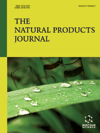- Home
- A-Z Publications
- Natural Products Journal, The
- Previous Issues
- Volume 2, Issue 1, 2012
Natural Products Journal, The - Volume 2, Issue 1, 2012
Volume 2, Issue 1, 2012
-
-
FOREWORD
More LessThe Natural Products Journal has completed its first year successfully and now enters its second year. The journal has attracted articles from many active scientists in this field. The first volume contained interesting articles on thermophilic fungal enzyme systems, cytotoxic fatty acids, natural pesticides for bio-control agents, novel anti-tumor compounds and on many other frontier fields. I am confident that with the contributio Read More
-
-
-
A Systematic Review of the Evidence for Use of Herbal Medicine for the Treatment of Acute Diarrhea
More LessAuthors: Zahra Asgari, Beatrice J. Selwyn, Helena Vonville and Herbert L. DuPontAcute diarrhea (AD) is an important cause of morbidity and mortality among both children and adults. An ideal antidiarrheal treatment should be safe, effective, compatible with Oral Rehydration Solution, and inexpensive. Herbal medicines, if effective, should fit these criteria as well or better than standard treatment. The objective of the present study was to assess the effectiveness of plant preparations in patients with AD in Read More
-
-
-
Helicteres isora L.-“Mrigashringa”- Current Strategies and Future Aspects
More LessAuthors: Varsha Tiwari, Anita Singh and Abhishek TiwariHelicteres isora L. is an important medicinal plant which has been reported to posses phyto-constituents like alkaloida, glycosides, phytosterols, fixed oils and fats, phenolic compounds among which Cucurbitacin B and Isocucurbitacin B (cytotoxic principle) are of keen interest. Its diverse medicinal properties include anti-diabetic, anticancer, antispasmodic, anti-hyperglycemic, antioxidant, glycaemic control and renoprotec Read More
-
-
-
Metabolites of 3'-O-acetylhamaudol Isolated from Angelica japonica Roots, and their Antitumor Actions
More LessAuthors: Yoshiyuki Kimura, Maho Sumiyoshi, Masahiko Taniguchi and Kimiye BabaObjective: We previously reported antitumor effects of 3'-O-acetylhamaudol isolated from Angelica japonica roots. However, 3'-O-acetylhamaudol could not be detected in blood after its oral administration. In this study, we examined the antitumor effects and mechanisms of action of metabolites of 3'-O-acetylhamaudol. Methods: Metabolites of 3'-O-acetylhamaudol were isolated from blood plasma by HPLC. The effect Read More
-
-
-
Opioid Alkaloids in Fire Poppies, Papaver Californicum
More LessAuthors: James David Adams, Shin-Yu Lee, Julie Eunwoo Kim, Jirair Petrosyan, Mona Shahgholi and Roger ClemensP. Californicum (Papaveraceae), fire poppy, is traditionally used against pain. The seed pods were found to contain glycosides of 14-methylnormorphine and papaverine. The major alkaloid, ignimorphinan C67H80O19N2, is a mixture of sterol glycoside dimers of 14-methylnormorphine and papaverine. The second most abundant alkaloid, ignipapaverine C44H55O10N, is a sterol glycoside of papaveri Read More
-
-
-
Limonoids from Melia azedarach with Deterrent Activity against Insects
More LessAuthors: Martina Diaz, Lucia Castillo, Carmen Elisa Diaz, Azucena Gonzalez-Coloma and Carmen RossiniThe ethanolic extract of ripe fruits of Melia azedarach (Meliaceae) and its subfractions were tested against four insect species, portraying important agricultural pests. Five limonoids were isolated: two tirucallane type triterpenoids never isolated before from this species (21α-methylmelianodiol, 21β-ethylmelianodiol), as well as three ring C-seco limonoids previously reported on this tree (1-O-detigloyl-1-O-cinnamoylohchinolal, 1- Read More
-
-
-
More Phenolic Derivatives with an Irregular Sesquiterpenyl Side Chain from Macaranga pruinosa
More LessAuthors: Yana M. Syah and Emilio L. GhisalbertiThree new flavonol derivatives, macapruinosins D-F (1-3), together with a known flavonoid glyasperin A, had been isolated from the acetone extract of the leaves of Macaranga pruinosa. The structures of the new compounds were identified based on their spectroscopic data, including UV, IR, 1D and 2D NMR, and HREIMS spectra. Compounds 1 - 2 were further examples of phenolic compounds having an irregular sesquiter Read More
-
-
-
Antimicrobial and Radical Scavenging Activities of N-Hydroxycinnamoyl - L-Cysteine and - L-Proline Ethyl Esters
More LessHydroxycinnamic acids are widely distributed in the plant kingdom secondary metabolites, found also as simple derivatives including amides, esters, and glycosides. These acids and their derivatives are known to possess antibacterial, antiviral, anti-inflammatory, antioxidative, antiproliferative, immunostimulatory and neuroprotective properties. The aim of the present work was the synthesis of new hydroxycinn Read More
-
-
-
Volatile Compounds Profile of Musa FHIA 02: An Option to Counter Losses by Black Sigatoka
More LessIn order to prevent the spread of banana diseases in Brazil, the government is expecting to replace the cultivation of sensitive varieties for other pest-resistant cultivars. But if the sensory properties are not taken into account, the breeding program may not succeed. The aim of this work was to compare the volatile compounds profile of Fhia 02 (AAAB group), resistant to black leaf streak disease, with its non resistant female g Read More
-
-
-
Antiulcer Activity of Lemon (Citrus limon) Fruit Juice and Its Interaction with Conventionally used Antiulcer Drugs in Rats
More LessLemon (Citrus limon) fruit is used for culinary and non-culinary purposes throughout the world. In traditional medicine, lemon fruit juice is used as home remedy for a variety of gastrointestinal disorders. This study evaluates the effect of lemon juice on gastric and duodenal ulcers and determines its interaction with conventionally used antiulcer drugs; pantoprazole and ranitidine. The antiulcer activity of lemon juice at t Read More
-
-
-
Anti-Oxidative Effect of Curcumin Against Tert-Butylhydroperoxide Induced Oxidative Stress in Human Erythrocytes
More LessAuthors: Prabhakar Singh and Syed Ibrahim RizviCurcumin (diferuloylmethane, 1, 6-heptadiene-3, 5-5dione-1, 7-bis (4-hydroxy-3-methoxyphenyl)), a constituent of turmeric (curcuma longa), is traditionally used in various diseases. We report the strong anti-oxidative effect of curcumin on markers of oxidative stress in human erythrocytes subjected to in vitro oxidative stress by incubating with tert-butylhydroperoxide (t-BHP). Results show that curcumin protects erythrocyte Read More
-
Most Read This Month
Article
content/journals/npj
Journal
10
5
false
en


